Geochemistry of Petroleum Gases and Liquids from the Inhassoro, Pande and Temane Fields Onshore Mozambique
Abstract
:1. Introduction
2. Materials and Methods
3. Results
3.1. Geochemistry and Origin of Gases
3.2. Geochemistry and Origin of Petroleum Liquids
4. Discussion
5. Conclusions
- (1)
- Studied petroleum gases have a pure thermogenic origin with no evidence of primary microbial gas (contrary to suggestions in [24]) or biodegradation. These gases were generated mostly by marine shale source rocks with little addition of gases from other source types. The gases are relatively dry (methane-dominated) and were generated in late oil—dry gas windows.
- (2)
- Most condensates have relatively high API gravity, up to 76 degrees. They apparently were generated in the condensate-gas maturity windows. These condensates contain traces of biomarkers, which were likely picked up during migration from source rocks to reservoirs.
- (3)
- Light oil in the Inhassoro field contains biomarkers likely related to the source rocks and likely originated from sub-oxic marine shales of the Late Cretaceous age.
- (4)
- Aptian-Coniacian Domo Shale is the likely source rock for the petroleum gases and liquids in the studied fields. Based on source-specific and age-specific biomarkers, coals in the Late Carboniferous—Early Jurassic Karoo Supergroup do not appear to be effective source rocks for the studied fields (contrary to suggestions in [2]).
- (5)
- Our interpretation of source rock age, organofacies and characteristics implies modest future exploration potential and gas dominance in the Mozambique basin.
Acknowledgments
Author Contributions
Conflicts of Interest
References
- Förster, R. The geological history of the sedimentary basin of southern Mozambique Channel. Palaeogeogr. Palaeoclimatol. Palaeoecol. 1975, 17, 267–287. [Google Scholar] [CrossRef]
- De Buyl, M.; Flores, G. Southern Mozambique basin: The most promising hydrocarbon province offshore east Africa. AAPG Mem. 1986, 40, 399–425. [Google Scholar]
- Salman, G.; Abdula, I. Development of the Mozambique and Ruvuma sedimentary basins, offshore Mozambique. Sediment. Geol. 1995, 96, 7–41. [Google Scholar] [CrossRef]
- Dale, K.; Hutchinson, I.; Loegering, M. The Pande gas fields complex in the Mozambique Basin, a case history. East Africa: From Research to Reserves. Geol. Soc. 2016, 78–81. [Google Scholar]
- Dale, K.; Kusiak, J. The Pande gas fields complex in the Mozambique basin, a case history. In Proceedings of the 14th HGS/PESGB Conference on African E&P “Always Something New Coming Out of Africa”, London, UK, 3–4 September 2015; pp. 1–3. [Google Scholar]
- Nairn, A.E.M.; Lerche, I.; Iliffe, J.E. Geology, basin analysis, and hydrocarbon potential of Mozambique and the Mozambique Channel. Earth-Sci. Rev. 1991, 30, 81–124. [Google Scholar] [CrossRef]
- Salazar, M.U.; Baker, D.; Francis, M.; Kornpihl, D.; West, T. Frontier exploration offshore the Zambezi Delta, Mozambique. First Break 2013, 31, 135–144. [Google Scholar]
- Abdula, I.; Salman, G. Exploration geology, potential of Pande gas field, Mozambique basin. Oil Gas J. 1995, 93, 102–106. [Google Scholar]
- Kihle, R. Recent surveys outline new potential for offshore Mozambique. Oil Gas J. 1983, 81, 126–134. [Google Scholar]
- Milkov, A.V.; Goebel, E.; Dzou, L.; Fisher, D.A.; Kutch, A.; McCaslin, N.; Bergman, D. Compartmentalization and time-lapse geochemical reservoir surveillance of the Horn Mountain oil field, deep-water Gulf of Mexico. Am. Assoc. Pet. Geol. Bull. 2007, 91, 847–876. [Google Scholar] [CrossRef]
- Bernard, B.; Brooks, J.M.; Sackett, W.M. A geochemical model for characterization of hydrocarbon gas sources in marine sediments. In Proceedings of the 9th Annual OTC Conference, Houston, TX, USA, 2–5 May 1977; pp. 435–438. [Google Scholar]
- Whiticar, M.J. Carbon and hydrogen isotope systematics of bacterial formation and oxidation of methane. Chem. Geol. 1999, 161, 291–314. [Google Scholar] [CrossRef]
- Milkov, A.V. Methanogenic biodegradation of petroleum in the West Siberian basin (Russia): Significance for formation of giant Cenomanian gas pools. Am. Assoc. Pet. Geol. Bull. 2010, 94, 1485–1541. [Google Scholar] [CrossRef]
- Milkov, A.V. Worldwide distribution and significance of secondary microbial methane formed during petroleum biodegradation in conventional reservoirs. Org. Geochem. 2011, 42, 184–207. [Google Scholar] [CrossRef]
- Chung, H.M.; Gormly, J.R.; Squires, R.M. Origin of gaseous hydrocarbons in subsurface environments: Theoretical considerations of carbon isotope distribution. Chem. Geol. 1988, 71, 97–104. [Google Scholar] [CrossRef]
- Dzou, L.; Milkov, A.V. Advanced interpretations of stable isotopic composition of gases in working petroleum systems. In Search and Discovery Article #90134, Proceedings of the Hedberg Conference Natural Gas Geochemistry, Beijing, China, 9–12 May 2011. [Google Scholar]
- Berner, U.; Faber, E. Empirical carbon isotope/maturity relationships for gases from algal kerogens and terrigenous organic matter, based on dry, open-system pyrolysis. Org. Geochem. 1996, 24, 947–955. [Google Scholar] [CrossRef]
- Curiale, J.A. A review of the occurrences and causes of migration-contamination in crude oil. Org. Geochem. 2002, 33, 1389–1400. [Google Scholar] [CrossRef]
- Peters, K.E.; Walters, C.C.; Moldowan, J.M. The Biomarker Guide, 2nd ed.; Part I, “Biomarkers and Isotopes in the Environmental and Human History”, and Part II “Biomarkers and Isotopes in Petroleum Exploration and Earth History”; Cambridge University Press: Cambridge, UK, 2005; 1155p. [Google Scholar]
- Sofer, Z. Stable carbon isotope compositions of crude oils: Application to source depositional environments and petroleum alteration. Am. Assoc. Pet. Geol. Bull. 1984, 68, 31–49. [Google Scholar]
- Radke, M. Application of aromatic compounds as maturity indicators in source rocks and crude oils. Mar. Pet. Geol. 1988, 15, 224–236. [Google Scholar] [CrossRef]
- Moldowan, J.M.; Dahl, J.; Huizinga, B.J.; Fago, F.J.; Hickey, L.J.; Peakman, T.M.; Taylor, D.W. The molecular fossil record of oleanane and its relation to angiosperms. Science 1994, 265, 768–771. [Google Scholar] [CrossRef] [PubMed]
- Grantham, P.J.; Wakefield, L.L. Variations in the sterane carbon number distributions of marine source rocks derived crude oils through geological time. Org. Geochem. 1988, 12, 61–73. [Google Scholar] [CrossRef]
- Coster, P.W.; Lawrence, S.R.; Fortes, G. Mozambique: A new geological framework for hydrocarbon exploration. J. Pet. Geol. 1989, 12, 205–230. [Google Scholar] [CrossRef]

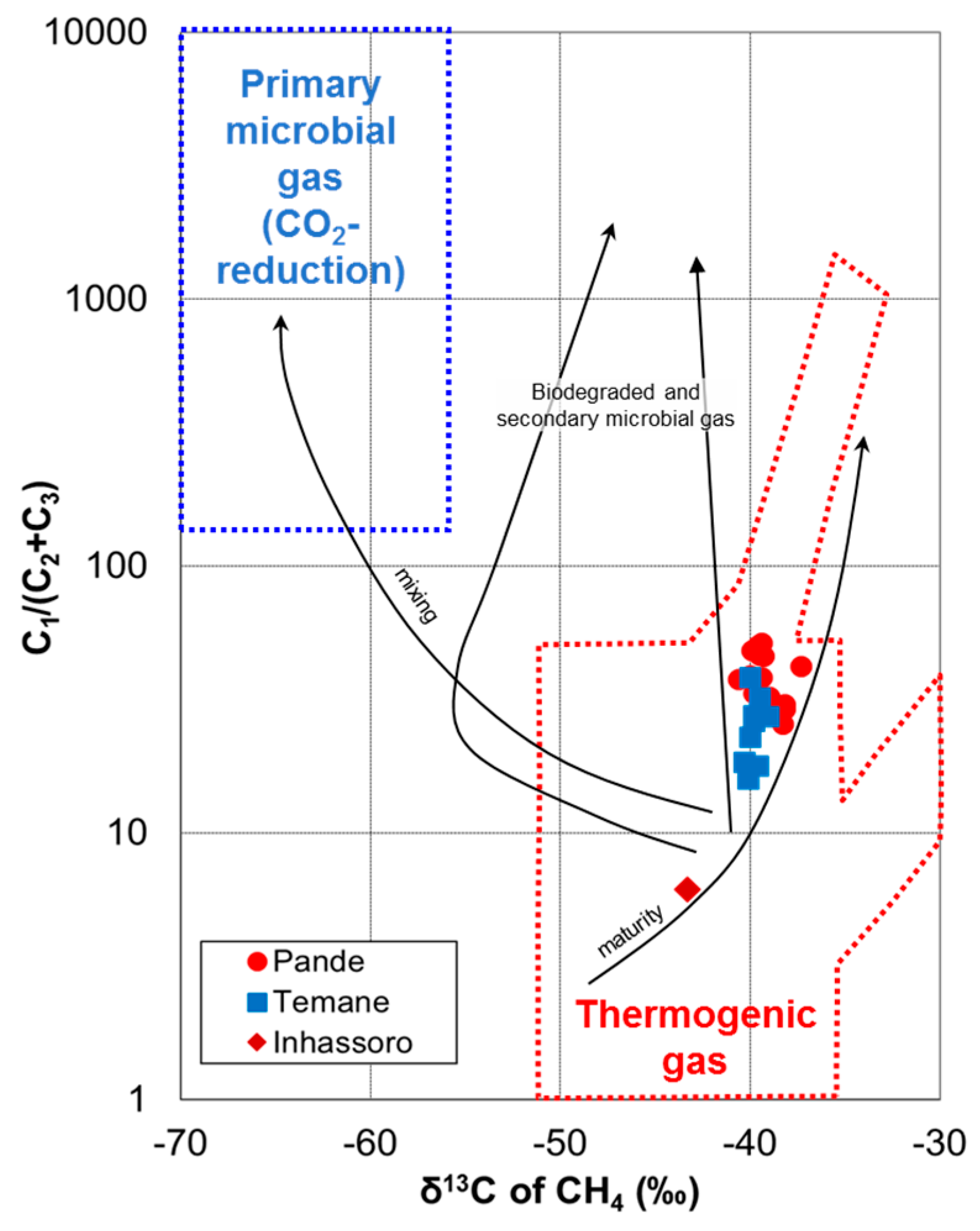

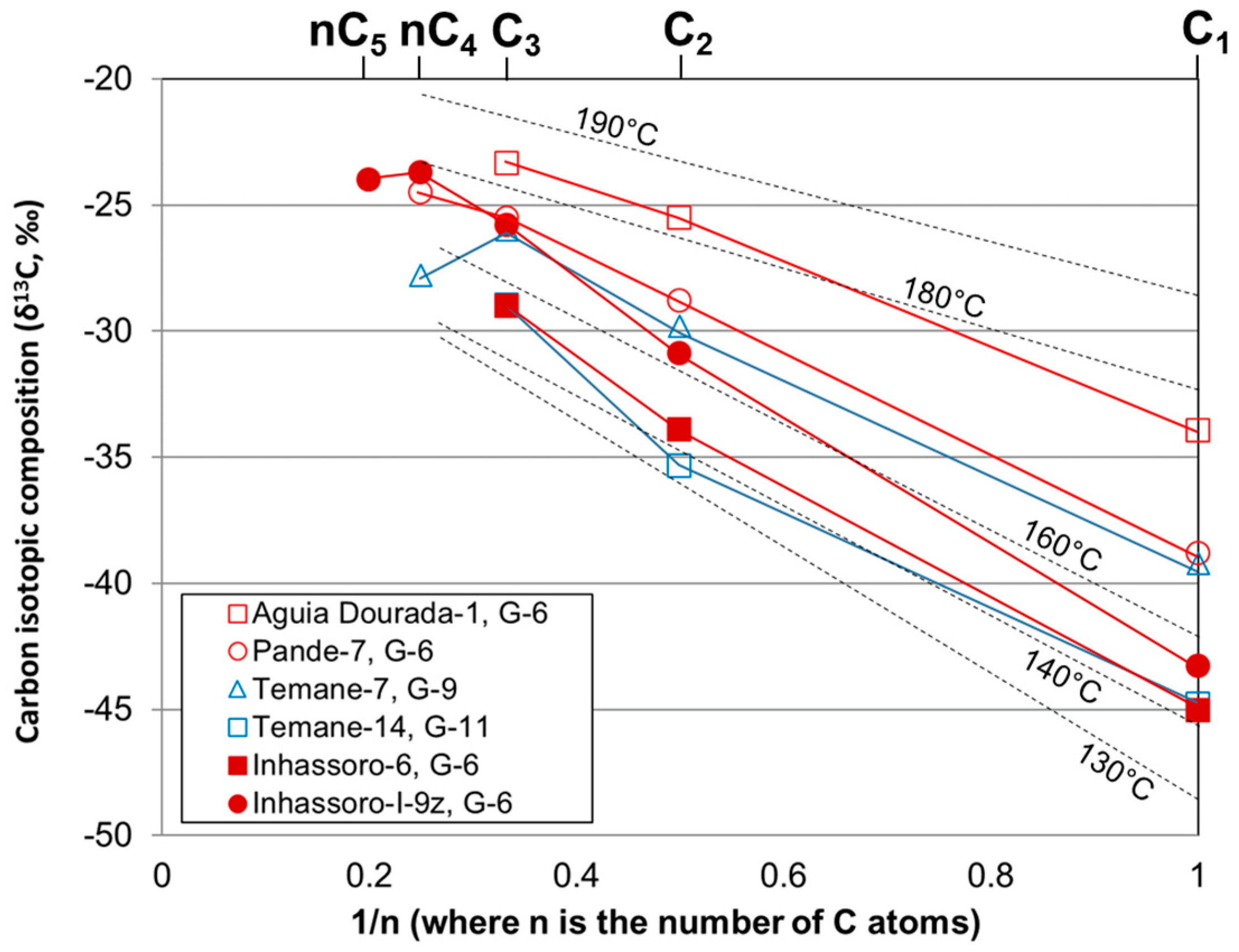
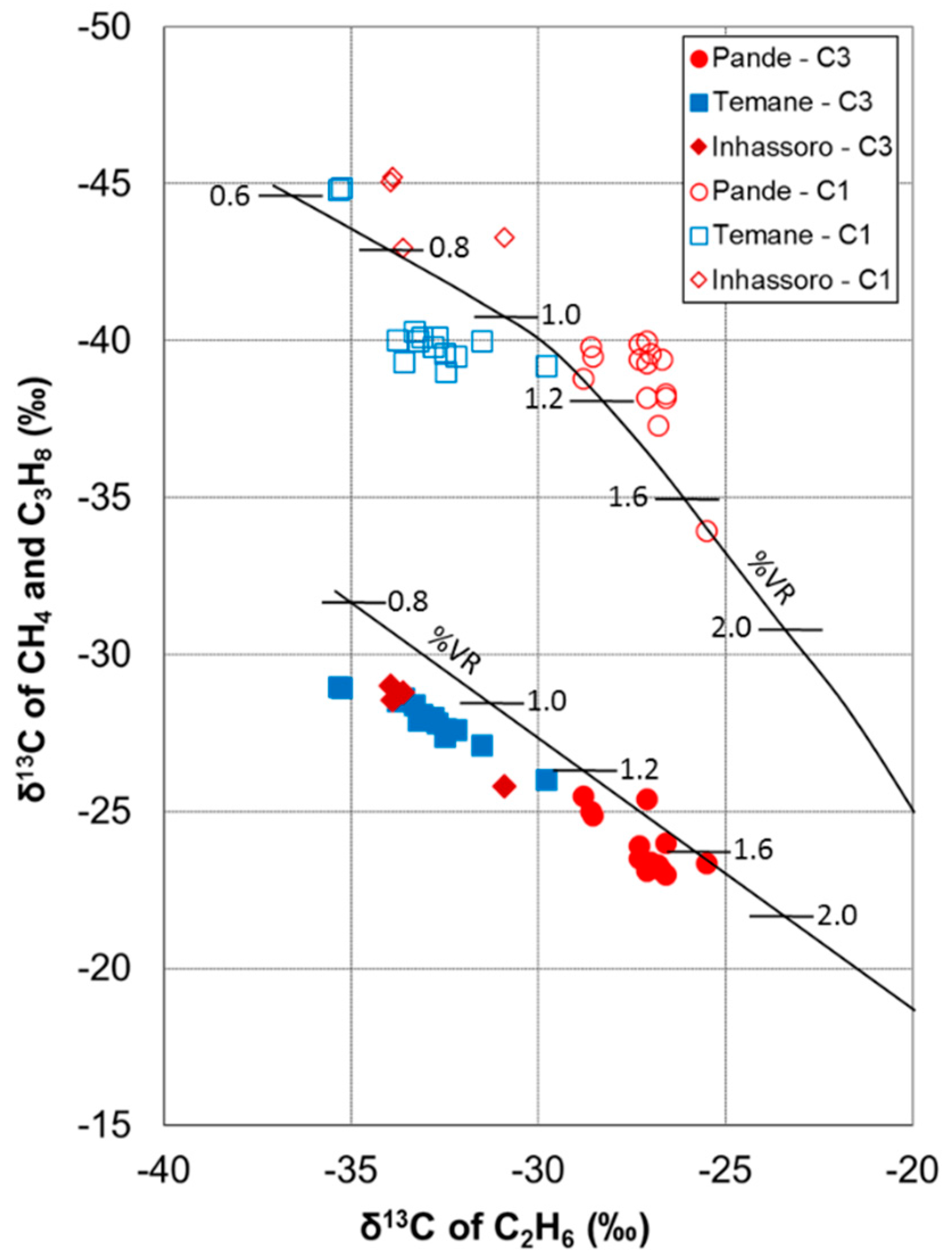
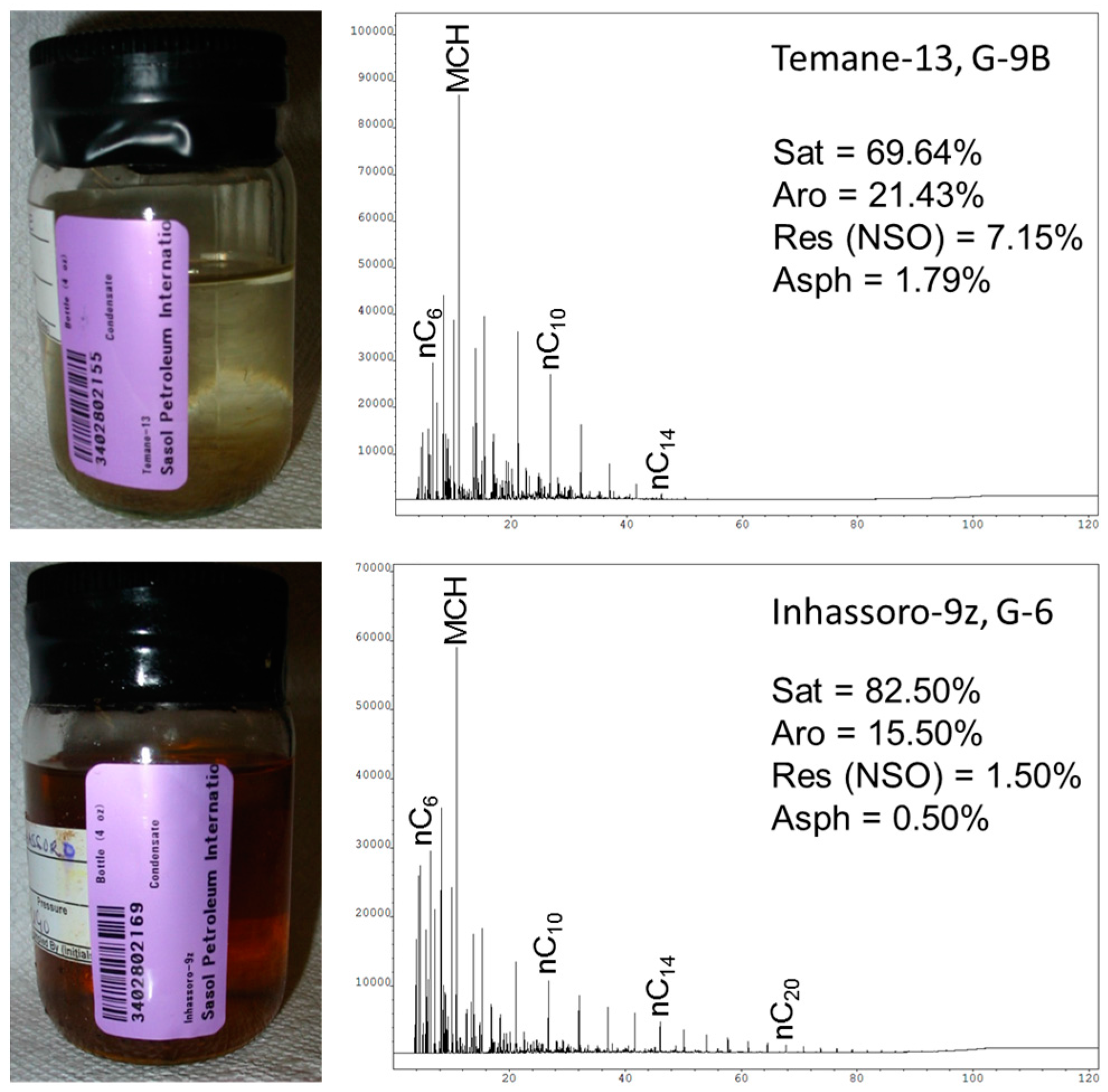
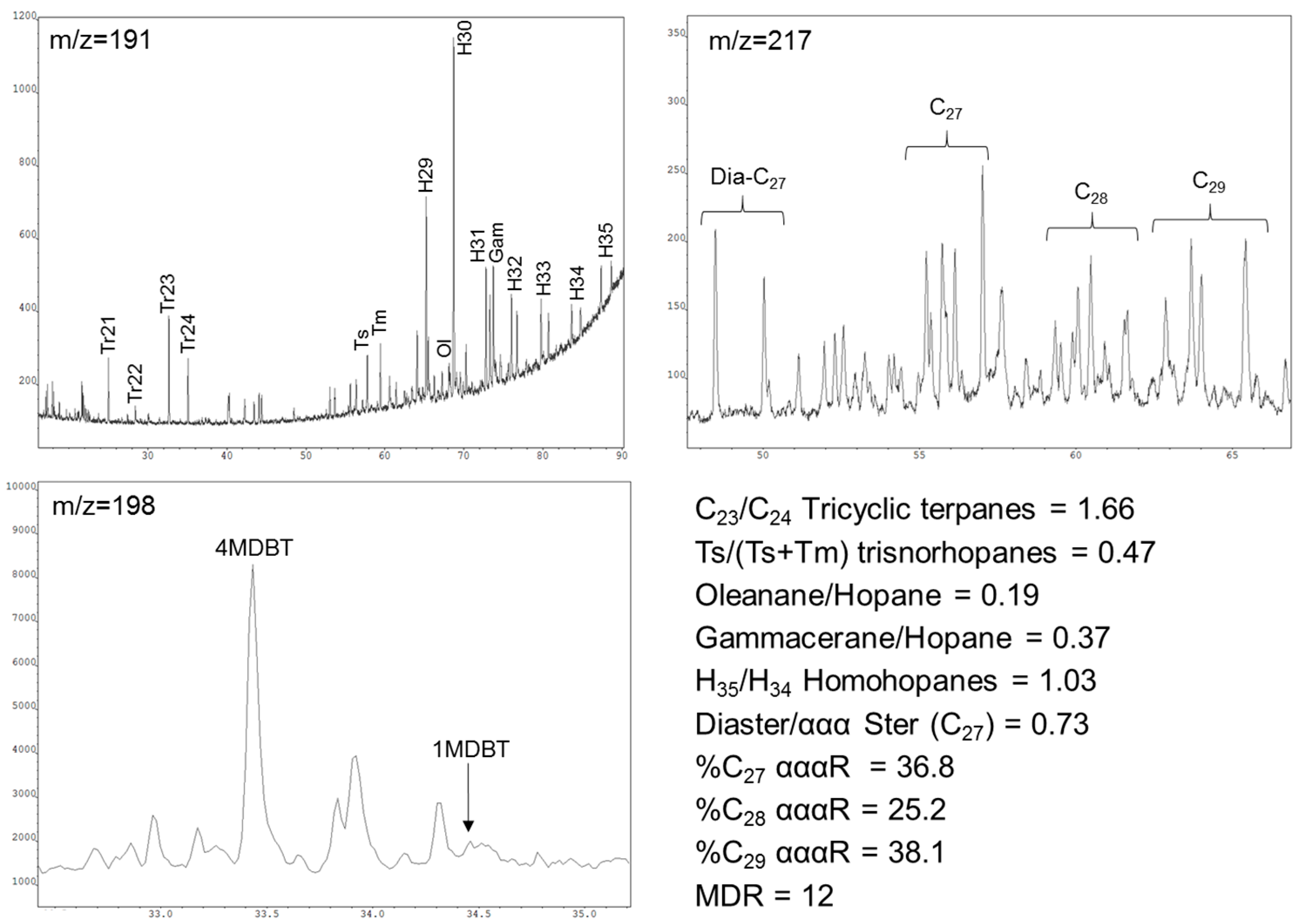
| Field | Well | Sample | Top Depth (m) | Base Depth (m) | Reservoir | Molecular Composition (mol %) | Ratios | ||||||||||||||
|---|---|---|---|---|---|---|---|---|---|---|---|---|---|---|---|---|---|---|---|---|---|
| C1 | C2 | C3 | iC4 | nC4 | iC5 | nC5 | C6+ | CO2 | N2 | O2 | Ar | He | H2 | C1/(C2+C3) | C1/(C1-C5) | ||||||
| Inhassoro | Inhassoro-4 | DST-1 | G-9 | ||||||||||||||||||
| Inhassoro | Inhassoro-4 | DST-2 | G-6 | ||||||||||||||||||
| Inhassoro | Inhassoro-6 | DST-3 | 1162.1 | 1172.8 | G-6 | ||||||||||||||||
| Inhassoro | I-9z | Wellhead | G-6 | 79.57 | 9.29 | 3.70 | 0.91 | 0.91 | 0.30 | 0.22 | 0.40 | 0.014 | 4.56 | 0.10 | 0.0228 | 0.0028 | nd | 6 | 0.838 | ||
| Pande | Aguia Dourada-1 | DST-1 | 1053.5 | 1062.7 | G-6 | ||||||||||||||||
| Pande | Pande North | G-6 | 94.94 | 1.75 | 0.77 | 0.23 | 0.25 | 0.10 | 0.12 | 0.46 | 0.68 | 0.0269 | 38 | 0.967 | |||||||
| Pande | Pande-14 | DST-2 | 1521 | 1529 | G-11 | 93.10 | 1.80 | 0.40 | 0.20 | 0.10 | nd | 4.40 | 42 | 0.974 | |||||||
| Pande | Pande-14 | DST-4 | 1150 | 1154 | G-6 | 92.40 | 2.80 | 0.80 | 0.50 | 0.20 | Trace | 3.30 | 26 | 0.956 | |||||||
| Pande | Pande-14 | DST-4 | 1150 | 1154 | G-6 | 93.60 | 2.40 | 0.80 | 0.40 | 0.10 | nd | 2.70 | 29 | 0.962 | |||||||
| Pande | Pande-14 | DST-4 | 1150 | 1154 | G-6 | 84.70 | 2.10 | 0.70 | 0.40 | 0.20 | nd | 11.90 | 30 | 0.961 | |||||||
| Pande | Pande-2 | G-6 | 95.59 | 2.39 | 0.56 | 0.17 | 0.20 | 0.07 | 0.07 | 0.34 | 0.10 | 0.0269 | 32 | 0.965 | |||||||
| Pande | Pande-5 | G-6 | 95.69 | 1.42 | 0.64 | 0.21 | 0.22 | 0.08 | 0.08 | 0.33 | 0.74 | 0.0269 | 46 | 0.973 | |||||||
| Pande | Pande-6 | G-6 | 95.82 | 1.33 | 0.57 | 0.18 | 0.20 | 0.08 | 0.07 | 0.37 | 0.85 | 0.0269 | 50 | 0.975 | |||||||
| Pande | Pande-7 | 1160 | 1180 | G-6 | 93.66 | 2.08 | 0.83 | 0.21 | 0.22 | 0.07 | 0.05 | 0.23 | 2.62 | 0.02 | 0.02 | 32 | 0.964 | ||||
| Pande | Pande-7 | G-6 | |||||||||||||||||||
| Pande | Pande-12 | Wellhead | G-6 | 94.98 | 1.59 | 0.47 | 0.12 | 0.12 | 0.04 | 0.03 | 0.10 | 0.006 | 2.46 | 0.042 | 0.0173 | 0.0136 | nd | 46 | 0.976 | ||
| Pande | Pande-16 | Wellhead | G-6 | 95.88 | 1.47 | 0.40 | 0.08 | 0.08 | 0.02 | 0.02 | 0.04 | nd | 1.94 | 0.036 | 0.0147 | 0.0176 | 0.0052 | 51 | 0.979 | ||
| Pande | Pande-19 | Wellhead | G-6 | 94.62 | 1.84 | 0.59 | 0.14 | 0.15 | 0.05 | 0.04 | 0.18 | nd | 2.31 | 0.037 | 0.0162 | 0.0166 | nd | 39 | 0.971 | ||
| Pande | Pande-21 | Wellhead | G-6 | 95.54 | 1.52 | 0.45 | 0.10 | 0.11 | 0.03 | 0.03 | 0.13 | 0.006 | 2.01 | 0.041 | 0.0183 | 0.0146 | 0.0018 | 48 | 0.977 | ||
| Pande | Pande-15 | Wellhead | G-6 | 93.90 | 2.03 | 0.79 | 0.22 | 0.23 | 0.08 | 0.06 | 0.26 | nd | 2.38 | 0.030 | 0.0163 | 0.0176 | nd | 33 | 0.965 | ||
| Pande | Pande-22 | Wellhead | G-6 | 95.66 | 1.51 | 0.48 | 0.12 | 0.13 | 0.04 | 0.03 | 0.16 | nd | 1.80 | 0.038 | 0.0135 | 0.0151 | nd | 48 | 0.976 | ||
| Pande | Pande-13 | Wellhead | G-6 | 94.12 | 1.82 | 0.64 | 0.18 | 0.18 | 0.06 | 0.05 | 0.18 | nd | 2.68 | 0.046 | 0.0186 | 0.0169 | nd | 38 | 0.970 | ||
| Temane | Temane-14 | PT-1 | G-12 | ||||||||||||||||||
| Temane | Temane-14 | PT-2 | G-11 | ||||||||||||||||||
| Temane | Temane-2 | 1295 | 1297 | G-7 | 93.39 | 2.32 | 1.10 | 0.26 | 0.33 | 0.10 | 0.08 | 0.39 | 2.01 | 0.01 | 0.02 | 27 | 0.957 | ||||
| Temane | Temane-2 | G-9 | 93.07 | 2.05 | 1.32 | 0.38 | 0.46 | 0.16 | 0.12 | 0.40 | 11.90 | 0.0269 | 28 | 0.954 | |||||||
| Temane | Temane-21 | PT-1 | G-8 | ||||||||||||||||||
| Temane | Temane-7 | Production test | 1283.5 | 1307.5 | G-9 | ||||||||||||||||
| Temane | Temane-9 | DST-2 | G-9 | ||||||||||||||||||
| Temane | Temane-15 | Wellhead | G-9A | 90.51 | 3.34 | 1.84 | 0.48 | 0.53 | 0.15 | 0.11 | 0.22 | nd | 2.75 | 0.038 | 0.0158 | 0.0159 | nd | 17 | 0.933 | ||
| Temane | Temane-4 | Wellhead | G-9A | 90.06 | 3.26 | 1.78 | 0.46 | 0.50 | 0.14 | 0.10 | 0.20 | nd | 3.42 | 0.042 | 0.0180 | 0.0167 | 0.0081 | 18 | 0.935 | ||
| Temane | Temane-5 | Wellhead | G-9A | 92.87 | 2.82 | 1.22 | 0.28 | 0.31 | 0.09 | 0.07 | 0.21 | nd | 2.05 | 0.043 | 0.0149 | 0.0163 | 0.0047 | 23 | 0.951 | ||
| Temane | Temane-10 | Wellhead | 94.30 | 2.05 | 0.89 | 0.21 | 0.25 | 0.07 | 0.06 | 0.18 | nd | 1.91 | 0.040 | 0.0137 | 0.0159 | 0.0078 | 32 | 0.964 | |||
| Temane | Temane-7 | Wellhead | G-9B | 94.51 | 1.77 | 0.70 | 0.17 | 0.21 | 0.07 | 0.06 | 0.20 | nd | 2.22 | 0.050 | 0.0151 | 0.0178 | 0.0147 | 38 | 0.969 | ||
| Temane | Temane-6 | Wellhead | G-9B | 89.79 | 3.59 | 2.02 | 0.52 | 0.57 | 0.16 | 0.11 | 0.22 | nd | 2.94 | 0.045 | 0.0163 | 0.0160 | 0.0013 | 16 | 0.928 | ||
| Temane | Temane-16 | Wellhead | G-9B | 93.09 | 2.37 | 1.19 | 0.35 | 0.38 | 0.13 | 0.10 | 0.21 | nd | 2.11 | 0.039 | 0.0144 | 0.0160 | 0.0028 | 26 | 0.954 | ||
| Temane | Temane-13 | Wellhead | G-9B | 90.95 | 3.30 | 1.65 | 0.41 | 0.45 | 0.13 | 0.10 | 0.29 | nd | 2.64 | 0.042 | 0.0163 | 0.0146 | 0.0020 | 18 | 0.938 | ||
| Field | Well | Sample | Top Depth (m) | Base Depth (m) | Reservoir | Carbon Isotopic Composition δ13C (‰) | Hydrogen Isotopic Composition δ2H (‰) | ||||||||
|---|---|---|---|---|---|---|---|---|---|---|---|---|---|---|---|
| C1 | C2 | C3 | iC4 | nC4 | iC5 | nC5 | C1 | C2 | C3 | ||||||
| Inhassoro | Inhassoro-4 | DST-1 | G-9 | −45.2 | −33.9 | −28.6 | −193 | ||||||||
| Inhassoro | Inhassoro-4 | DST-2 | G-6 | −43.0 | −33.6 | −28.8 | −201 | ||||||||
| Inhassoro | Inhassoro-6 | DST-3 | 1162.1 | 1172.8 | G-6 | −45.1 | −33.9 | −29.0 | −187 | ||||||
| Inhassoro | I-9z | Wellhead | G-6 | −43.3 | −30.9 | −25.8 | −25.2 | −23.7 | −24.6 | −24.0 | −156 | −116 | −109 | ||
| Pande | Aguia Dourada-1 | DST-1 | 1053.5 | 1062.7 | G-6 | −34.0 | −25.5 | −23.4 | −169 | ||||||
| Pande | Pande North | G-6 | −40.6 | −138 | |||||||||||
| Pande | Pande-14 | DST-2 | 1521 | 1529 | G-11 | −37.3 | −26.8 | −23.3 | |||||||
| Pande | Pande-14 | DST-4 | 1150 | 1154 | G-6 | −38.3 | −26.6 | −23.0 | |||||||
| Pande | Pande-14 | DST-4 | 1150 | 1154 | G-6 | −38.2 | −27.1 | −25.4 | |||||||
| Pande | Pande-14 | DST-4 | 1150 | 1154 | G-6 | −38.2 | −26.6 | −24.0 | |||||||
| Pande | Pande-2 | G-6 | −39.0 | −137 | |||||||||||
| Pande | Pande-5 | G-6 | −39.5 | −137 | |||||||||||
| Pande | Pande-6 | G-6 | −39.6 | −136 | |||||||||||
| Pande | Pande-7 | 1160 | 1180 | G-6 | −39.5 | −28.6 | −24.9 | −22.9 | −24.2 | −146 | |||||
| Pande | Pande-7 | G-6 | −38.8 | −28.8 | −25.5 | −22.9 | −24.5 | −155 | |||||||
| Pande | Pande-12 | Wellhead | G-6 | −39.3 | −27.1 | −23.2 | −21.9 | −21.0 | −22.0 | −21.7 | −143 | −111 | −111 | ||
| Pande | Pande-16 | Wellhead | G-6 | −39.4 | −26.7 | −23.1 | −21.8 | −20.8 | −26.7 | −21.5 | −143 | ||||
| Pande | Pande-19 | Wellhead | G-6 | −40.0 | −27.1 | −23.1 | −22.2 | −21.0 | −21.9 | −21.7 | −143 | ||||
| Pande | Pande-21 | Wellhead | G-6 | −39.9 | −27.3 | −23.9 | −22.5 | −21.5 | −24.0 | −21.8 | −143 | ||||
| Pande | Pande-15 | Wellhead | G-6 | −39.8 | −28.6 | −25.0 | −24.1 | −22.5 | −23.6 | −22.6 | −144 | −112 | −116 | ||
| Pande | Pande-22 | Wellhead | G-6 | −39.6 | −27.0 | −23.4 | −22.7 | −21.4 | −22.0 | −21.5 | −143 | ||||
| Pande | Pande-13 | Wellhead | G-6 | −39.4 | −27.3 | −23.5 | −22.8 | −21.6 | −22.9 | −22.2 | −140 | ||||
| Temane | Temane-14 | PT-1 | G-12 | −44.9 | −35.3 | −28.9 | −198 | ||||||||
| Temane | Temane-14 | PT-2 | G-11 | −44.8 | −35.3 | −29.0 | −201 | ||||||||
| Temane | Temane-2 | 1295 | 1297 | G-7 | −39.0 | −32.5 | −27.6 | −24.8 | −26.8 | −141 | |||||
| Temane | Temane-2 | G-9 | −39.8 | −138 | |||||||||||
| Temane | Temane-21 | PT-1 | G-8 | −39.3 | −33.6 | −28.6 | −188 | ||||||||
| Temane | Temane-7 | Production test | 1283.5 | 1307.5 | G-9 | −39.2 | −29.8 | −26.0 | −27.8 | −144 | |||||
| Temane | Temane-9 | DST-2 | G-9 | −40.0 | −33.8 | −28.5 | −187 | ||||||||
| Temane | Temane-15 | Wellhead | G-9A | −40.1 | −32.7 | −27.8 | −26.5 | −24.4 | −25.5 | −24.0 | −139 | ||||
| Temane | Temane-4 | Wellhead | G-9A | −39.6 | −32.5 | −27.4 | −26.4 | −24.1 | −25.1 | −23.8 | −141 | −118 | −109 | ||
| Temane | Temane-5 | Wellhead | G-9A | −40.0 | −33.2 | −27.9 | −27.0 | −24.5 | −25.8 | −24.2 | −140 | −115 | −114 | ||
| Temane | Temane-10 | Wellhead | −39.5 | −32.2 | −27.6 | −26.6 | −24.5 | −25.7 | −24.2 | −139 | |||||
| Temane | Temane-7 | Wellhead | G-9B | −40.0 | −31.5 | −27.1 | −26.4 | −24.4 | −26.5 | −24.2 | −140 | ||||
| Temane | Temane-6 | Wellhead | G-9B | −40.1 | −33.1 | −28.1 | −27.0 | −24.8 | −25.9 | −24.1 | −141 | ||||
| Temane | Temane-16 | Wellhead | G-9B | −39.8 | −32.8 | −28.0 | −26.9 | −24.9 | −26.0 | −24.2 | −140 | ||||
| Temane | Temane-13 | Wellhead | G-9B | −40.3 | −33.3 | −28.4 | −27.2 | −25.1 | −25.9 | −24.3 | −142 | −117 | −112 | ||
© 2017 by the authors. Licensee MDPI, Basel, Switzerland. This article is an open access article distributed under the terms and conditions of the Creative Commons Attribution (CC BY) license (http://creativecommons.org/licenses/by/4.0/).
Share and Cite
Loegering, M.J.; Milkov, A.V. Geochemistry of Petroleum Gases and Liquids from the Inhassoro, Pande and Temane Fields Onshore Mozambique. Geosciences 2017, 7, 33. https://doi.org/10.3390/geosciences7020033
Loegering MJ, Milkov AV. Geochemistry of Petroleum Gases and Liquids from the Inhassoro, Pande and Temane Fields Onshore Mozambique. Geosciences. 2017; 7(2):33. https://doi.org/10.3390/geosciences7020033
Chicago/Turabian StyleLoegering, Markus J., and Alexei V. Milkov. 2017. "Geochemistry of Petroleum Gases and Liquids from the Inhassoro, Pande and Temane Fields Onshore Mozambique" Geosciences 7, no. 2: 33. https://doi.org/10.3390/geosciences7020033





